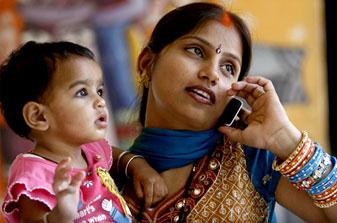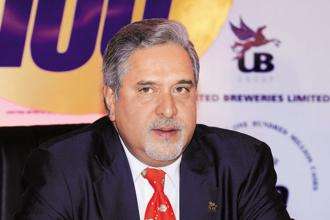February 26, 2012
n 1995, one year after India began to liberalize the telecom sector, the telephone was still a luxury for most Indians. A couple of years later, the newfound toy called the mobile phone was still a status symbol that required payments for incoming calls. Today, your milkman, your carpenter and the kabadiwala who collects your junk carries one.
February 26, 2012
n 1995, one year after India began to liberalize the telecom sector, the telephone was still a luxury for most Indians. A couple of years later, the newfound toy called the mobile phone was still a status symbol that required payments for incoming calls. Today, your milkman, your carpenter and the kabadiwala who collects your junk carries one.
A woman holds a child in her arm as she talks on a mobile phone in Allahabad. The multi-billion dollar third-generation (3G) telecom spectrum auction began on Friday.
Sometimes in the middle of this year, the number of mobile subscribers in India will cross one billion. The Telecom Regulatory Authority of India (TRAI) put the number at 893 million at the start of the year. That means 74 %, or three out of four Indians, have a phone connection (though that is literally not true as company connections and second connections inflate the number). “I remember as a child only people with very high standing in the society owned phones,” recalls Delhi-based businessman Arun Khanna.
Generation Y may not know this, but there was a time in India when one had to wait between 10 and 20 years to get a telephone connection.
Some decades ago, the waiting period for a telephone was anywhere between 10 and 20 years. “The joke used to be that if you wanted a phone for your child, book it when you got married,” joked B.K. Syngal, former chairman of the erstwhile Videsh Sanchar Nigam Ltd, who joined the Indian Telecom Service (ITS) in the early 1950s. Syngal, who has seen the industry move from a drought to a flood, sums up the metamorphosis. “There has been a shift from — Aap qatar mein hain, kripya pratiksha kijiye (You are in a queue, please wait) — to qatars (queues) of telemarketers bending over backwards to offer mobiles to consumers,” said Syngal.
In the early days of the cell phone, a one-minute call from Delhi to Mumbai used to cost about Rs35 a minute. And a call from India to the US cost twice as much. When mobile phones were launched in India, in 1994, the charge for a one-minute call was Rs16. Now a one-minute call costs as low as 45 paise per minute — less than 3 % of the then cost, despite intervening years of inflation and growth that makes the rupee go less far. You can now call anywhere in India for a rupee a minute and the normal rate for a call to the US is only Rs4 four per minute.
More than the cost, it is the lives that the cell phone has touched – and changed – that matters a lot to India. Consider Kanhaiya, a Delhi-based electrician who now counts his hand phone like he does his screwdriver. For him, it is a passport to customer access. “My mobile phone is my shop,” he says proudly. “Earlier, I was attached with a shop and the shopkeeper used to take 20% of what I earned just to send customers to me. Now, I don’t share my earnings with anyone,” he said.
In the rural hinterland, the hand phone helps villagers talk to urban cousins and local folk alike. Fishermen now get weather information on the phone. New software developed by the M.S. Swaminathan Research Foundation in partnership with telecom companies help them find the right place to get their shoals.
For them, it is a dramatic shift from the days, when catching fish was more about luck than knowledge.
Like fisher folk, farmers get food grain prices. They can choose to carry their stocks of grain to the local mandi (wholesale market) or not depending on what is the going price of the day. This makes them less vulnerable to India’s famous middlemen known to eat up profits by sitting between the farm and the fork.
The cell phone is also busy becoming a banking tool for those not touched by financial institutions.
A big initiative that the government, banks and the telecom service providers are taking is in mobile money transfer (MMT). Using software applications tied up in secure platforms, money can be transferred between accounts — or people. A number of banks and companies including Vodafone and Nokia are doing pilot projects for MMT. The government-owned Bharat Sanchar Nigam Ltd (BSNL) is also in the final stages of launching MMT in association with a large public sector bank. Once this becomes successful, it is expected to help large numbers of migrant workers who work in metros and cities. What was done with tedious money order forms will now be almost as easy as a text message.
Another big application of mobile telephony will be in the field of e-governance, under which government services can be paid for through mobile phone-based transactions.
Some state governments are already using mobile phone-based services to track their mid-day meal schemes aimed at helping schoolchildren.
At the upper end of society, the ubiquitous information technology (IT) and IT-enabled services industry is now worth $100 billion (Rs500000 crore). Call centres and BPO industries now employ hundreds of thousands of workers who are aided by the connectivity spawned by telephony and data linkages.
When the first mobile phone service was launched in India, the cost of a low end mobile handset was around R25,000. You can now buy one for Rs1,000. Smartphones, which bring the browsing power of the Net to your palmtop, can be bought for as low as Rs5,000.
The revolution has been aided by the liberalization programme that opened up the then Department of Telecommunications (DoT) to change. DoT’s service wing became Bharat Sanchar Nigam Limited, while regulatory powers went to the Telecom Regulatory Authority of India set up in 1997. Thanks to other policy measures, private firms entered the field to bring investments, and more important, competition. The beneficiary, clearly, was the consumer.
“There is a need to develop mobile infrastructure in villages. Only then the telecom revolution will be complete,” says K. N. Gupta, former executive director of Centre for Development of Telematics (C-DOT), an agency set up by the government in the 1980s to create rural-friendly technologies.
For all the big bluster, Bharat has miles to go in the telecom revolution before it catches up with India.
Source: Hindustan Times

















































































































